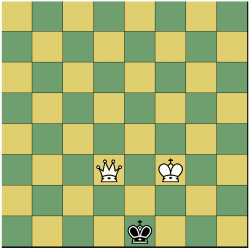This article is about the rules for how to draw a chess game.
A draw is a tie … neither player wins. Though a draw against a very strong player can feel very much like a win. You will often hear chess players brag of their draws … (“I got a draw against such and such grandmaster”).
How a chess game ends in a draw
There are five ways to end a chess game in a draw:
- Insufficient material to mate
- Stalemate
- Threefold repetition of position
- The fifty-move rule
- By agreement
Insufficient material to mate
In order to win the game, one side must have at least two minor pieces (the Bishop and the Knight are referred to as “minor” pieces; the Queen and Rooks are called “major” pieces), a Rook, or a Queen. Keep in mind, however, that if there is a Pawn on the board, there is always sufficient material for a mate because the Pawn could be promoted to a Queen. Bare Kings, King and Bishop against King, or King and Knight against King is a draw because there is not sufficient mating material. The stronger side must have at least King and Queen; King and Rook; King and two Bishops; or King, Bishop, and Knight. (King and two Knights against King is not enough to force mate, but that subject is beyond the scope of this article.)
Stalemate
The game is a draw if either King is stalemated. A stalemate occurs when the King is not in check, but has no legal moves. In the diagram below, if it is Black’s move, he has no legal move; Black is stalemated and the game is a draw. If it is White’s move, however, the game is not a draw, because Qe2 would be checkmate.

Threefold repetition of position
If the same position occurs three times on the chessboard with the same player to move (and the same castling and capturing privileges [the en passant capture might be a factor]), the game is a draw. “Perpetual check,” where one side repeatedly checks the enemy king over and over in an endless cycle, is a draw because of the threefold repetition rule.
The fifty move rule
If the players have made 50 moves without moving a Pawn, capturing a piece, or either side delivering checkmate, the game is a draw. This might occur in the more difficult checkmates (Bishop and Knight against King or King and Queen against King and Rook). It doesn’t occur very often.
By agreement of the players
By far the most common way of drawing a game is where the players agree to a draw. This occurs because the players foresee that the game will inevitably end in a draw by one of the other methods. In such a situation the rules allow the players to end the game as a draw by agreement.
How should I offer a draw?
The proper way to offer a draw to your opponent is to say, “I offer a draw,” then make your move, and punch your clock. The opponent then has as much time as he wishes to consider your draw offer … as long as his flag hasn’t fallen! Some players will offer a draw on their move and look at their opponent, expecting an answer. If you are going to wait for an answer, wait for it with your opponent’s clock running! And if you offer a draw, you have to wait for an answer. 🙂
If you have offered a draw and your opponent makes a move without responding, he has rejected the draw offer and it’s off the table. He can’t “accept” your draw offer two moves later.
Be sure to visit my chess store, Shop For Chess, for my recommended chess books and equipment!

Epic post, chess is great I’ve been playing eleven years, never get bored of it.
Really interesting piece for beginners. Thanks
Thanks for stopping by, Bruce! I’m glad you liked the article. 🙂
Yes.Threefold repetition rule:if an idicnetal position has just occurred three times with the same player to move, or will occur after the player on turn makes his move, the player on move may claim a draw (to the arbiter). In such a case the draw is not automatic a player must claim it if he wants the draw. When the position will occur for the third time after the player’s intended next move, he writes the move on his scoresheet but does not make the move on the board and claims the draw. Article 9.2 states that a position is considered idicnetal to another if the same player is on move, the same types of pieces of the same colors occupy the same squares, and the same moves are available to each player; in particular, each player has the same castling and en passant capturing rights. (A player may lose his right to castle; and an en passant capture is available only at the first opportunity.) If the claim is not made on the move in which the repetition occurs, the player forfeits the right to make the claim. Of course, the opportunity may present itself again.The fifty-move rule:if in the previous fifty moves by each side, no pawn has moved and no capture has been made, a draw may be claimed by either player. Here again, the draw is not automatic and must be claimed if the player wants the draw. If the player whose turn it is to move has made only 49 such moves, he may write his next move on the scoresheet and claim a draw. As with the threefold repetition, the right to claim the draw is forfeited if it is not used on that move, but the opportunity may occur again.Abiding by these rules, there are an infinite number of possible moves and, consequently, an infinite number of different possible chess games.In reality, if you were about to lose you would, of course, use the 50 move or the 3fold rule and claim a draw.When calculating how many possible different games of chess there are, another rule would have to be included in order to get a finite number. For example, by changing the 3fold rule so that the game ends automatically.
Thanks for posting the results of your research!
Wow I did not see a few of them and one I did what the beginner would have done for one of them. The funny part is I paelcd in the top ten grade 11 in Ontario, Canada. Better start to practice this summer. I normally would have seen that.
Practice, practice, practice! 🙂